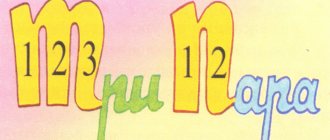- home
- Directories
- Handbook of Russian for elementary school
- Sounds and letters
- Consonant sounds and letters representing them
- Voiceless and voiced consonants
Consonant sounds can be pronounced with a greater or lesser degree of sonority. In accordance with this, voiced and voiceless consonants are distinguished.
Voiceless consonant sounds are made up of noise, while voiced consonant sounds are made up of noise and voice.
Some consonant sounds are paired in terms of voicedness and voicelessness , i.e. can be voiced or devoiced depending on their position in the word. And some are unpaired , i.e. their sound does not depend on position.
Table of consonant sounds paired and unpaired by voicedness/voicelessness:
| Groups consonants | Doubles | Unpaired |
| Voiced | [b], [b'], [c], [c'], [d], [g'], [d], [d'], [g], [h], [z'] | [th'], [p], [p'], [l], [l'], [m], [m'], [n], [n'] |
| Deaf | [p], [p'], [f], [f'], [k], [k'], [t], [t'], [w], [s], [s'] | [ts], [x], [x'], [h'], [w'] |
Consonant paired voiced sounds are deafened:
- at the end of the word - tooth b [zu p ], hundred g [hundred k ], plo v [plo f ]
- before voiceless consonant sounds - lips ki [gu p ki], spoon [ loshka ] , low [n'is ka ]
Consonant paired unvoiced sounds are voiced:
- before voiced consonant sounds - with delka [ z' d'elka], grind ba [small d' ba]
The correct spelling of paired consonants based on voicedness/voicelessness is an orthogram that requires a test word.
unpaired in terms of voicedness/voicelessness are not deafened or voiced, regardless of where in the word or before what sounds (voiced or voiceless) they are located.
For example: rubbish [litter], house [house], crust [crust], Dimka [dimka]
Share with friends on social networks:
Pronunciation problems
Defects
in
children, problems
associated with incorrect reproduction
of hard
“L” and soft “L” are usually divided into 2 large groups.
Presented in the table
:
| Group name | Type of deviation | Characteristic |
| Lambdacism | Nasal. | The child pronounces a sound with incorrect breathing. The air flow will enter the nasal passages. (“L” is replaced by “NG”). |
| Bilabial. | During pronunciation, the baby involuntarily makes a straw with his lips. It turns out that “L” is replaced with “U” (varnish with Uak; summer with Ueto, etc.) | |
| Interdental. | The tip of the tongue ends up in the interdental space. | |
| Absence of a letter in a conversation. | The child completely excludes the letter from the vocabulary (the lamp changes to Ampa). | |
| Paralambdacism (changes the phoneme to other sounds) | Replacing "L" with "V". Paw - Vapka; Moon - Vuna. | |
| Replacing "L" with "G". Chair – Stug; Meadow - Gug. | ||
| Replacing "L" with "D". Line - Desk; Fox - Dis. | ||
| Replacing the hard “L” with a soft one. Dala - Dalia. | ||
| Replacing “L” with “YA”, “Yo”, “YU”. Paw - Yapka; Spoon - Yozhka; Love - Yubov. | ||
Expert opinion
Margarita Sergeevna S.
Speech pathologist and speech pathologist with 15 years of experience working in various speech correction centers with children of different ages.
Any of the listed types of deviations can be eliminated with the help of speech therapy exercises and techniques.
Causes
In order to quickly form the correct
pronunciation
of a phoneme in a child, it is necessary to find out the root causes of the violations:
- bilingualism in the family;
- interdental pronunciation;
- the tongue is relaxed.
Note: Another reason for incorrect pronunciation of a sound is the age of the baby.
Children under 4 years old tend to make mistakes and confuse phonemes in words.
When such cases occur, the baby experiences incorrect placement of the speech organs. The position of the tongue is poorly designed, so the sound is distorted. There are situations when the defect is associated with breathing problems during a conversation:
- formation of phonemes with lips;
- the tip of the tongue does not touch the teeth. It just goes down and the sound is lost;
- the tip of the tongue is behind the lower teeth, and its middle is closer to the palate. When reproducing the phoneme “L” it should be the other way around.
Each of the above reasons is eliminated in individual lessons.
with a speech therapist and doing
homework .
to eliminate
deficiencies
in a short period of time, subject to regular work.
Important:
for dysarthria, it is necessary to perform complex exercises under the supervision of specialists. The presence of the disease presupposes a phased production of the phoneme “L”.
Unpaired voiced sonorants
As noted above, all sonorants belong to voiced consonant sounds. Unlike most voiced consonants, sonorant sounds do not have voiceless pairs. If other consonants, such as [d], [d'], [b], [b'], [z], [z'] and others have paired voiceless [t], [t'], [p] , [p'], [s], [s'], then the sonorant sounds [l], [l'], [m], [m'], [n], [n'], [r], [ р'], [й'] do not have such a pair among voiceless consonants. All sonorant sounds according to this feature are unpaired. They are not deafened in any position: neither at the end of a word, nor before voiceless consonants. They are always pronounced loudly - with vocal force, and ordinary paired consonants at the end of a word and before voiceless consonants are pronounced dull.
This is easy to check by comparison:
"home": before
[m] – “frost”: moro [s]; “day”: de[n'] – “copper”: me[t']; “breakdown”: shelf[m]ka – boat: boat[t]ka; “slice”: do[l']ka – “radish”: re[t']ka.
- The consonants R, L, M, N, J are called sonorant.
- All only voiced, unpaired consonants help to remember the phrase:
LEMON IS PARADISE!
If you delete all the vowels in this sentence, then only voiced, unpaired consonant sounds will remain.
| Hard sonorous sounds | Sonorant sounds, with the exception of the sound [th'], have a pair of hardness: [l] - [l'], [m] - [m'], [n] - [n'], [r] - [r' ]. In certain positions they can be pronounced both softly and firmly: “elk”: [l]os – “salt”: so[l']; “mol”: [m]mol – “mel”: [m']mel; “bottom”: d[n]o – “day”: de[n’], “lynx”: [r]lyx – “door”: two[r’]. The sound [y'] is not pronounced firmly under any circumstances, and does not have a hardness pair: “egg” - [y'ay'tso]. It's just soft. In its sound, it is the closest of the sonorant sounds to vowel sounds, especially close to - [and]. Sometimes it is even called “and - short” |
| Voiced sonorant consonants | All sonorant sounds are only voiced sounds, there are no dull sounds among them!!! |
| Voiceless sonorous sounds | There are no dull sounds among sonorants!!! |
| Hissing sonorous sounds | There are no hissing sonorous sounds!!! |
Correct articulatory position of the speech organs
When pronouncing “L”, the speech apparatus takes the position:
- Lips half open. The position is completely neutral to pronounce the vowel phoneme after the consonant sound.
- The upper and lower teeth are slightly open.
- The tip of the tongue rests on the upper jaw (teeth or gums). The rest of the tongue is completely down.
- The lateral edges of the tongue and the far teeth form a small space between each other on both sides. An air stream passes through the slots.
The formation of the soft sound "L" is slightly different. The lips assume the same position as when smiling. The tip of the tongue focuses on the alveoli (tubercles behind the front incisors). The rest of the tongue is slightly raised.
Demonstrated in pictures
,
how to put
the sounds “L” and “L”:
Definition
Sonorant sounds are voiced consonant sounds in which the voice dominates the noise. The word “sonorous” comes from the Latin – “sonorous”, which translated into Russian means “sonorous”. The sonorant group includes eight paired softness-hardness ones and one soft unpaired one: [l] - [l'], [m] - [m'], [n] - [n'], [r] - [r '], [th].
Sonorous sounds, as a rule, are formed with the participation of the lungs, vocal cords, lips, tongue, and palate. Teeth are not involved in their formation. According to the place and method of formation, they are: labiolabial - [m], [m']; lingual-labial – [n], [n']; lingual-palatal – [l], [l'], [r], [r'], [th']. In terms of sound strength, they are all voiced.
Exercises for the speech apparatus
Articulation gymnastics —
the most important component of successfully overcoming
pronunciation
deficiencies Completing tasks
with an emphasis on the speech organs is
a preparatory stage
before setting the phoneme. Basic exercises for training the mobility of the lips and tongue:
- Hammock . Use the tip of your tongue to touch your upper teeth. The rest of the organ is bent downwards, forming a hammock. Stay in this position for 10-15 seconds.
-
. Move the wide tongue first along the upper, then along the lower lip. In this case, the lips should be motionless.
Delicious jam - Turkey . The tongue licks its lips at an accelerated pace. At this time, the child should try to say bl-bl-bl-bl.
Horse.
The baby is asked to imitate the clicking of an animal's hooves. The tip of the tongue flicks the roof of the mouth.- Wide smile.
The baby is asked to stretch his lips into a smile as far as possible and freeze in this position for a few seconds. The exercise will be repeated 2-3 times.
Note: classes help train articulation
if it is difficult to place any types of phonemes - voiceless or voiced , hard or soft, etc.
Breathing exercises
The sounds “L” and “L” are produced as you exhale. To correctly place the phoneme, experts recommend regularly performing inhalation-exhalation exercises:
- Stop, horse! Take a deep breath, and as you exhale say br-br-br.
- Ball.
The baby is asked to lie down on the floor. Hands are placed on the tummy. As you inhale, the “ball” (tummy) inflates, and as you exhale, it deflates. - Ship. A paper boat is lowered into a basin of water. The baby is offered to move it with a stream of air.
Breathing exercises are performed for 2-3 minutes daily.
Advice: a detailed
work plan and more detailed methods of training the speech organs are provided by a speech therapist. The specialist will explain how to quickly and effectively carry out the exercises.
Setting sounds [L], [L']
When correctly pronouncing the sounds [L] , [L'], the articulatory organs occupy the following position: • the position of the lips depends on adjacent, mainly subsequent, vowel sounds; • the upper and lower incisors are located at a small distance from each other; • the tongue rests its tip on the upper incisors or their gums; • the lateral edges do not meet the upper molars, resulting in passages for exhaled air remaining on the sides; • the root of the tongue with the hard sound [L] is raised; • the soft palate is raised, closing the passage into the nasal cavity; • vocal cords are closed and vibrate.
The articulation of the soft sound [L'] differs from the articulation of the hard sound [L] in that it is not the root part of the tongue that rises, but the anteromedial part of its back. Not only the tip of the tongue meets the gums, but also a significant surface of the front part of the back of the tongue with the alveoli (sometimes the sound [L'] is pronounced with the tip of the tongue lowered by closing the front part of the back with the alveoli). It is rarely possible to correct a violation of the pronunciation of the sound [L] based on imitation.
In cases where special difficulties arise due to insufficient plasticity of the tongue, a series of articulations should be performed, leaving passages on the sides for exhaled air.
Exercises for lips “Smile”. Smile so that the upper and lower teeth are visible, and hold this position for 5-7 seconds. "Tube". Stretch your lips with a tube: 1st option - pronounce the sound [U] for a long time without using your voice; 2nd option - the lips are pulled slightly forward, as if forming a square. The teeth are closed. "The doors are opening." Slowly open your mouth until there is a distance of 10-15 mm between the upper and lower teeth, hold your lips in the “Smile” position.
Exercise for developing an air jet “Hunter”. Bite the tip of the narrowed tongue with your teeth, inhale and exhale air through the side slits.
Exercises for the tongue “Needle”. Lips in the “Smile” position. Push your long, narrow tongue forward between your teeth. "Pancake." Place a wide, relaxed tongue on the lower lip. Make sure that the lower lip does not tense. The upper teeth should be exposed (that is, the “Smile” position is maintained). If the tongue does not take the desired shape, it is recommended to do a passive massage, pronounce syllables with the tongue sticking out between the lips, for example, “Ba-ba-ba.” Upon achieving success, make your tongue wide without pronouncing these syllables and blow with a narrow stream of air until a groove is formed along the midline of the tongue. You should alternate between the “Needle” and “Pancake” exercises. "Swing". Smile, show your teeth, open your mouth slightly, put your wide tongue behind your lower teeth (from the inside) and hold in this position for a count of one to five. Then lift your wide tongue by the upper teeth (also from the inside) and hold it for a count of one to five. Alternately change the position of the tongue 4-6 times. “Click the tip of your tongue.” Smile, show your teeth, open your mouth slightly and click the tip of your tongue (“like a horse clicking its hooves”). "Turkey". Open your mouth slightly, put your tongue on your upper lip and move the wide front edge of your tongue along your upper lip back and forth, trying not to lift your tongue from your lip - as if stroking it. First, make slow movements, then speed up the tempo and add your voice until you get “bl-bl” (“like a turkey babbling”). "Nut". The tongue rests from the inside on the right and then on the left cheek. "The steamer is humming." Pronounce the sound [Y] for a long time and with tension, without closing your teeth.
After carrying out the preparatory exercises, you should choose one of the techniques for setting the sound [L]. • The speech therapist invites the child to pronounce the sound [Y] with the tip of the tongue in an interdental position, reinforcing this position when pronouncing syllables, words and sentences that include the sound [L]. As the sound [L] becomes stronger in this position, the interdental articulation of the sound [L] gradually becomes interdental. • In cases where a child replaces the sound [L] with a bilabial [V], you should use your fingers to spread the upper and lower lips, pressing them against the exposed incisors, between which the spread tip of the tongue is inserted (until the child gets out of the habit of pushing his lips forward) . • In some cases, you can ask the child to open his mouth wide so that the lower and upper teeth are visible. When pronouncing the sound [A] for a long time, the child should touch the upper incisors with the tip of the narrowed tongue. You may get a combination of [L] with the vowel [A] (“la”). If the sound [L] sounds soft, you need to bite the narrow tip of the tongue with your incisors. After receiving the correctly pronounced sound [L], you should move on to automating the sound in syllables and words using cards.
Similar articles: Setting the sounds [S], [Z] and [C], Setting the sounds [P], [P'].
Methods for making the sounds L and L
What sound can you make the sound L from?
determined individually for each child, taking into account capabilities and skills. In speech therapy practice, the following methods are distinguished:
- By imitation. Performed while sitting in front of a mirror. The baby is shown the correct location of the speech organs in the reflection and asked to repeat. After a successfully completed task, they are asked to sound out the letter in this position.
Note: the lesson is most suitable for children with a complete absence of phonemes in words, when there is no need to rearrange the established positions of organs during reproduction.
- Setting from the letter “Y”. Occurs in a playful way, simulating a steamship. The baby is asked to smile broadly. Lightly bite your tongue and pronounce the sound “Y” in a drawn-out manner. It will smoothly turn into a drawn-out l-l-l. You can try this exercise with other vowel sounds.
- Setting from the letter "B". The lesson is aimed at inhibiting the lower lip. When pronouncing the letter “B”, the baby should not move his lower lip. If it doesn’t work, the adult holds the sponge with his finger. For preschoolers
, they read special
poems
or sing
songs
with an abundance of the letter “L” in the words and ask them to repeat. - Production from the sound “L”. A soft sound is pronounced more readily by a child. It does not require tongue tension and is faster. To get a solid phoneme, the baby is asked to reproduce syllables
(La, Lo, Lu). At the same time, they are asked to reach the upper lip with the tip of their tongue. - Mechanical method. Performed using a special tool or clean fingers. Carry out the manipulation only under the supervision of a speech therapist or with his participation. The tongue is asked to be lifted by the upper incisors. The instrument maintains it at the desired level during pronunciation of the phoneme. The method is suitable for patients with dysarthria.
Expert opinion
Margarita Sergeevna S.
Speech pathologist and speech pathologist with 15 years of experience working in various speech correction centers with children of different ages.
The above methods can be performed one at a time or several can be used at once. All the secrets
You can learn how to perform the techniques during a consultation with a speech therapist.
Classification of consonants
By noise level:
| By noise level | |
| Sonorous | — voice predominates, noise level is insignificant - [l], [m], [n], [r], [th]; |
| Noisy | - significant noise level. Noisy ones are divided into:
|
| By hardness | |
| Solid | [l], [d], [s], [g], [ts], [w], etc. |
| Soft | [l,], [d,], [s,], [w,], [h,], [th], etc. |
Among the voiced consonants, there are 9 sounds in which there is more voice than noise. These are sonorant sounds.









